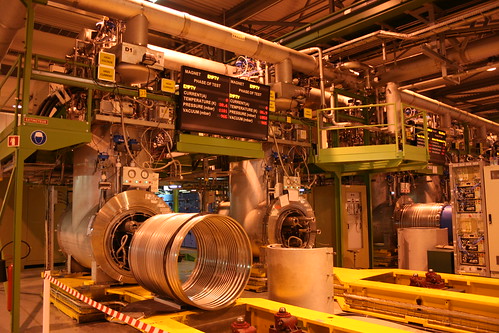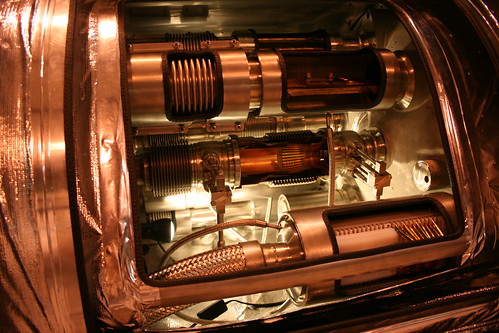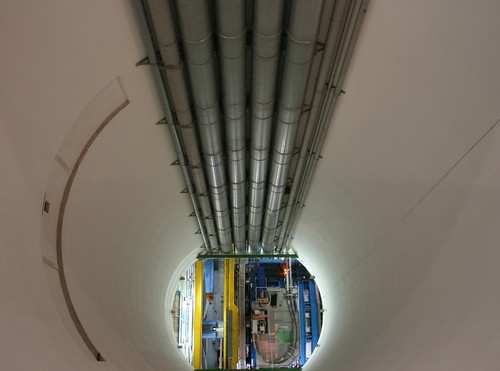Monday morning I headed out to CERN. Having worked in a nuclear physics institut before, I have a fascination with cutting edge research and the incomprehensible theories it spawns. And as a web developer I was interested in seeing the place where the internet was invented. But mainly I was drawn by the certain masculine appeal of the biggest, most powerful machine in the world, designed to smash stuff up.
This is very precise destruction though. Built with Swiss acuracy on the Switzerland-France border, the facility sprawls around the 27km tunnel through which steams of particles are accelerated and then smashed together. In fact the experiments require such precision that scientists must compensate for the 1mm variation in length of the 27km circuit caused by the moon's tidal pull on the bedrock - that's right, rocks have tides too.
The Museé Microcosm has the unenviable task of trying to explain why the particles must be destroyed in laymans terms. Begining by explaining that everything is made of atoms, within a few panels a live version of Rutherfords gold foil experiment takes place. The top half of the museum continues with the pop-culture statistics that you would expect (the LHC will produce enough data in a year to produce a stack of DVD's 15km high (No cases)), but still has no explanation of what the collisions will achieve. Instead it looks at the spectacular engineering feat behind the LHC.
For example, to bend the particle stream around the ring, electro-magnets are used to focus and angle the beam. If normal warm magnets were used, the ring would have to be 120km in circumference to provide the energies the LHC requires. Rather than dig that big a tunnel, the scientists opted to cool the magnets to around 1 kelvin to make them superconductors.
This of cource means that the 27km of equipment must be kept at -271 celsius, a feat which requires 500 tons of liquid helium. Each meter of magnet experiences the force equivalent to the weight of a jumbo jet when in operation, and if a single piece of the titanium-niobium wire is not accurately placed, then the friction generated by its movement can heat it enough to cause a 'quench' - where the metal loses it's superconductivity and immediately receives the resistance associated with the 7TeV travelling through it.
As far as I can tell from the scant information in the CERN journal, and by talking to scientists, this is what happened in the 'incident' which took CERN out of action last year. Apparently one of the thousands of solder connections between magnets was poorly made and caused it to arc. Normally quenches within the ring are handled by a subsystem which redirects the current into big copper blocks, but for some reason this didn't happen when the joint quenched. The magnetic field, combined with the superheated helium resulted in an explosion distorting the ring and damaging 37 of the magnets. These are being repaired on the surface, however they have also been replaced with spares. I heard rumours that the poor solder joints were due to a hurry to meet the deadline, this time around everything is being checked and double checked in a much more painstaking way.
The bottom half of the museum went into more depth and attempted to explain a little of the science behind the CERN experiments, although it was dissapointingly disjointed, mentioning topics without introducing them and lacking a consistent narrative. Consequently I still have no idea of the difference between quarks, or understand the mass-energy relation in bosons.
The museum seemed a little small, and I really only came to see the real equipment, but apparently tours have to be booked a month in advance. Not having a month, I did what any self respecting person would do, and tried to sneak in with a Swiss school tour. Unfortunately I can no longer pass for a schoolkid and was caught, but a little bit of charm offensive and I managed to wangle my way onto the tour anyway.
Unfortunately the tour began with an hour long lecture, and as the school was from Zurich, it was in German. I passed the time by watching the students fall asleep - I don't know whether schoolkids in Switzerland are meant to know the difference betwen electron and tau neutrinos, but there was at least 10 minutes of passionate German on that slide, followed by one on antimatter - I think they understood less of the lecture than I did.
A lesser man may have given up after the lecture, but I figured they'd have to show us some cool stuff to make up for the lecture.
We were walked across the road and for one horrible moment I thought we would be taken into the 'Dan Brown' exhibit - yes that's right, the dude who writes airport trash about albino monks bombing the Vatican gets an exhibition at CERN. They claim it falls under their mandate of 'spreading knowledge' - I thought it interesting that they spread that knowledge, but prevented visitors from acessing their wifi - I mean, they invented the internet.
Luckily we turned towards the ATLAS facility where we watched a 3D film about the construction of the detector. The film was set to upbeat music; I don't think there are many funnier things than watching a room full of Swiss students wearing oversized earphones and polarised glasses dancing to a science video.
As I was beginning to despair of ever seeing real equipment (and a little tempted to peak inside the temptingly named and under surveilled "Control Room") we were taken inside the cavernous warehouse that sits atop the detector shaft. While the guide prattled on about the properties of some wire or something I peered down the shaft 100m down to the tunnel below.
After the guide had finished his spiel we piled onto a bus and went to France. The French facility is used for testing the magnets, and like most scientific facilities, was a shiny pile of organised mess. I have no idea of what was explained here, the warehouse was filled with some extremely fancy plumbing - sections of the tunnel below us.
As we drove back to the reception at the end of the tour, I managed to talk to one of the guides in English. He told me about his research project which used technology developed for the detectors of the LHC to make better mammograms. So there we have it - the biggest machine on earth, made to smash stuff, and ultimately, if tangentially, save lives.


